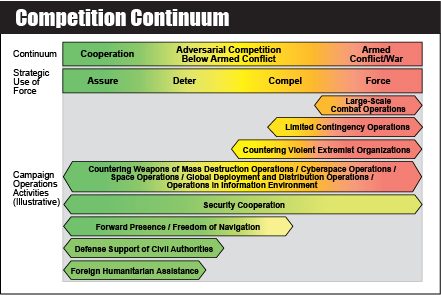The four strategic uses of the military instrument of national power- assurance; both forms of coercion, deterrence and compellence; and forcible action – are implemented through campaigns, operations, and activities that vary in purpose, scale, risk, and intensity, and occur across a competition continuum.

The competition continuum describes three broad categories of strategic relationships among the actors in the operational environment—cooperation, competition below armed conflict, and armed conflict/war—to distinguish relationships between actors and clarify options for the use of military force within each context. During campaigns and operations, the joint force will likely cooperate with allies and other partners, compete against adversaries, and fight enemies concurrently in the same operational environment.
The competition continuum describes a world of enduring competition conducted through a mixture of cooperation, competition, and armed conflict. These descriptors refer to the relationship between the United States and another strategic actor (state or non-state) concerning a set of specific policy objectives. This description allows for simultaneous interaction with the same strategic actor at different points along the competition continuum. Elements of the competition continuum include:
A. Cooperation
Situations in which joint forces take actions with another strategic partner in pursuit of policy objectives. Cooperation does not preclude some element of competition or even armed conflict when their objectives are not in complete alignment. Within cooperation, joint force actions may include SC activities, multinational training and exercises, information sharing, personnel exchange programs, and other military engagement activities. Military cooperation may also occur in the form of multinational operations and activities during armed conflict or competition.
B. Competition
Competition is when joint forces or multinational forces take actions outside of armed conflict against a state or non-state adversary in pursuit of policy objectives, but neither seeks armed conflict. These actions are typically nonviolent and conducted under greater legal or policy constraints than in armed conflict but can include lethal and nonlethal actions by the joint force or sponsorship of surrogates or partners. Competition does not preclude some cooperation in other areas. Competition may include diplomatic and economic activities, political subversion, intelligence and CI activities, CO, OIE, special operations, and other nonviolent or intermediate force activities to achieve mutually incompatible objectives while seeking to avoid armed conflict. Joint force actions may include combinations of offense, defense, and stabilization activities; SC activities; MISO; freedom of navigation exercises; and other nonviolent military engagement activities. Competition does not preclude armed conflict or cooperation in other areas. Concurrent with competition, state or non-state forces may engage in forms of armed conflict (e.g., external support of an insurgency, COIN, or resistance movement).
C. Armed Conflict/War
Armed conflict/war occurs when military forces take actions against an enemy in hostilities or declared war. International law distinguishes armed conflict from disturbances (e.g., riots, violent protests) by the intensity of the conflict and the organization of the parties.
The competition continuum describes, from the joint force perspective, the environment in which the United States applies the instruments of national power (i.e., diplomatic, informational, military, and economic) to achieve objectives. In practice, all instruments of national power should function together as an interrelated and integrated whole.
Cooperation, competition, and armed conflict can, and often do, occur simultaneously. Cooperation is a feature of nearly every significant military action because the joint force rarely operates unilaterally in any significant operation or campaign. In an interconnected world, there are few circumstances in which a major joint force activity does not have some ramifications for competition with at least one of the US’s global or regional rivals. Cooperation and competition are always occurring, and the presence or absence of armed conflict is normally the only variable element. In either case, the joint force will be conducting cooperative activities with partners and competitive activities below armed conflict to counter adversaries who are seeking to turn the competition or conflict to their advantage. The joint force is never solely in cooperation but instead campaigns through a mixture of cooperation, competition, and armed conflict calculated to achieve the desired strategic objectives.
Editor’s Note: As outlined above, joint doctrine describes the strategic environment in terms of a competition continuum. However, Army doctrine describes the strategic situation through three strategic contexts in which Army forces conduct operations. The Army strategic contexts generally correspond to the joint competition continuum and the requirements of joint campaigns. Read our related article on “Army Strategic Contexts.”
 This article is an extract from "JFODS6: The Joint Forces Operations & Doctrine SMARTbook, 6th Ed. (Guide to Joint Warfighting, Operations & Planning)" by The Lightning Press. Download a free PDF sample and learn more at: JFODS6: The Joint Forces Operations & Doctrine SMARTbook, 6th Ed. (Guide to Joint Warfighting, Operations & Planning).
This article is an extract from "JFODS6: The Joint Forces Operations & Doctrine SMARTbook, 6th Ed. (Guide to Joint Warfighting, Operations & Planning)" by The Lightning Press. Download a free PDF sample and learn more at: JFODS6: The Joint Forces Operations & Doctrine SMARTbook, 6th Ed. (Guide to Joint Warfighting, Operations & Planning).
Browse additional military doctrine articles in our SMARTnews Blog & Resource Center.
About The Lightning Press SMARTbooks. Recognized as a “whole of government” doctrinal reference standard by military, national security and government professionals around the world, SMARTbooks comprise a comprehensive professional library. SMARTbooks can be used as quick reference guides during operations, as study guides at education and professional development courses, and as lesson plans and checklists in support of training. Browse our collection of Military Reference SMARTbooks to learn more.













































